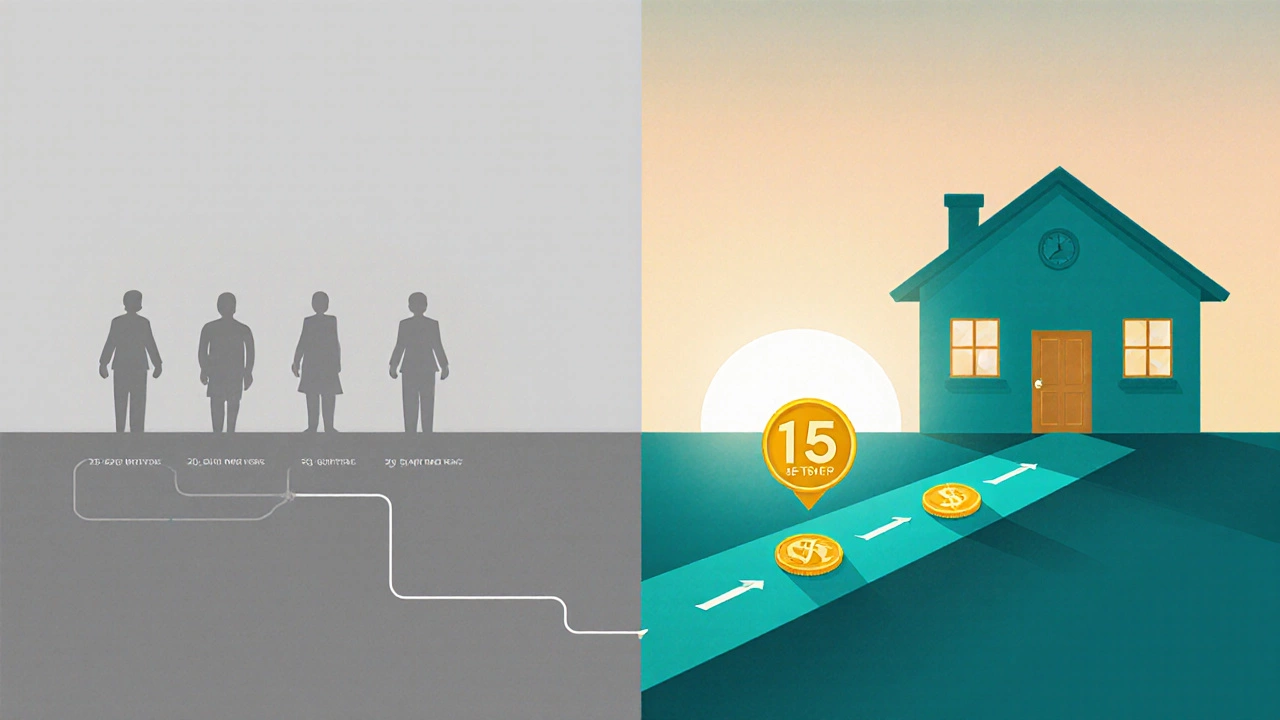Home Loan Extra EMI Calculator
Calculate Your Savings
Enter your loan details to see how paying 2 extra EMIs per year can help you pay off your home loan faster.
Tenure Reduction Progress
Comparison with Standard Loan
Imagine you have a 30‑year mortgage and every year you slip in two extra instalments. What does that do to your balance, your interest bill, and the day you finally own your home outright? The short answer: you shave years off the loan and save a hefty chunk of money. The longer answer dives into the math, the real‑world steps, and the hidden traps you need to watch out for.
What a Home Loan and an EMI Actually Are
When we talk about a Home loan is a long‑term debt taken to purchase residential property, typically repaid in equal monthly instalments called EMI (Equated Monthly Installment). The EMI amount combines two components: a slice of the principal amount and the interest accrued on the remaining balance.
Because the interest is calculated on the outstanding principal each month, the earlier you reduce that principal, the less interest you will pay overall. That principle is the engine behind the "extra EMI" strategy.
How Paying Two Extra EMIs a Year Works
Most borrowers think of their loan as a fixed schedule: 360 payments for a 30‑year loan, 240 for a 20‑year loan, and so on. Adding two extra EMIs per year means you make 24 + 2 = 26 payments each year. Those two bonus instalments go straight toward the principal because the interest component of a regular EMI is already accounted for in that month’s payment.
In practice, you can either:
- Make the extra EMIs as lump‑sum payments at the end of each year, or
- Spread them out as an additional 1/12th of an EMI each month (about 8.33 % extra per month).
Running the Numbers - A Step‑by‑Step Example
Let’s break down a typical Indian scenario:
- Loan details: ₹30,00,000 principal, 8.5 % annual interest, 20‑year tenure.
- Standard EMI: Using the standard amortisation formula, EMI ≈ ₹26,358.
- Extra payments: Two additional EMIs per year add ₹52,716 to the yearly outlay.
- Impact on tenure: After running the schedule with the extra payments, the loan clears in about 15.3 years instead of 20.
- Total interest saved: Roughly ₹9,40,000 less interest over the life of the loan.
Those figures come from a simple spreadsheet that recalculates the outstanding balance after each payment. The key takeaway is that a 25 % increase in yearly cash outflow (2 extra EMIs) cuts the loan term by about 23 % and slashes interest by a similar margin.

Side‑by‑Side Comparison
| Metric | Standard Schedule | With 2 Extra EMIs/Year |
|---|---|---|
| Loan tenure | 20 years (240 months) | ≈15.3 years (184 months) |
| Total interest paid | ≈₹13,20,000 | ≈₹3,80,000 |
| Annual cash outflow | ₹3,16,296 | ₹3,68,? (₹26,358 × 12 + ₹52,716) |
| Equity built after 5 years | ≈₹5,20,000 | ≈₹9,40,000 |
The table makes the trade‑off crystal clear: a modest boost in yearly outlay translates into huge savings and earlier ownership.
Beyond the Numbers - Real Benefits
- Faster equity: Each extra EMI chips away at the principal, so you own a larger slice of the property sooner. This can be handy if you plan to sell or refinance.
- Lower risk: A shorter loan means lower exposure to interest‑rate hikes if your loan is floating.
- Psychological win: Seeing the balance drop faster can be motivating and reduces the mental burden of a long‑term debt.
- Tax angle: In India, interest on a home loan up to ₹2 lakh per year is deductible under Section 24(b). Paying less interest simply means you’ll hit that ceiling sooner.
Potential Pitfalls to Watch
Before you rush to the bank, keep these in mind:
- Prepayment penalties: Some lenders charge a fee (usually 0.5‑2 % of the prepaid amount) if you clear part of the loan before a certain period. Check your loan agreement.
- Cash‑flow squeeze: Adding two EMIs means an extra ₹52,716 each year. Make sure your emergency fund can cover that extra outlay.
- Tax timing: The interest deduction limit is per financial year. If you prepay a large chunk, you might lose out on the full deduction for that year.
- Bank processing: Not all banks automatically apply extra payments to the principal. Get written confirmation that the extra EMIs will reduce the outstanding balance directly.
How to Set Up the Extra EMI Plan
- Read your loan contract: Look for any clause on prepayment or part‑payment penalties.
- Talk to your lender: Ask if they allow “extra EMI” or “additional principal payment” and how to instruct them.
- Choose a method:
- Automatic extra debit: Set up a standing instruction for an extra amount each month.
- Lump‑sum each year: Transfer the extra EMIs on your loan account on the anniversary of the loan start date.
- Get a revised amortisation schedule: Most banks will issue an updated table showing the new tenure and interest savings.
- Monitor: After the first few extra payments, verify the principal reduction on your next statement.
Most banks in India now have online portals where you can add an “Additional Payment” directly. If you prefer face‑to‑face, a quick visit to the branch will do.
Quick Checklist - Your Extra EMI Playbook
- Confirm prepayment charges (if any).
- Calculate the extra yearly amount (2 × EMI).
- Ensure you have at least 6 months of emergency savings after adding the extra payment.
- Set up automatic extra debit or schedule annual lump‑sum.
- Request updated amortisation schedule and keep it for reference.
- Re‑evaluate yearly - if your income grows, you can add more than two EMIs.
Frequently Asked Questions
Will paying extra EMIs increase my monthly EMI amount?
No. The regular EMI stays the same. The extra payments are additional amounts that go straight toward the principal.
How many extra EMIs can I pay without a penalty?
It depends on your lender. Some banks allow unlimited part‑payments after a lock‑in period; others cap it at a percentage of the outstanding balance per year.
Does the interest deduction under Section 24(b) change if I prepay?
The deduction limit stays ₹2 lakh per FY, but you may hit that ceiling faster because you’ll pay less total interest.
What if I miss an extra EMI?
Missing an extra payment simply means the loan continues on the original schedule. It won’t trigger a penalty, but you lose the interest‑saving benefit for that year.
Is it better to pay two EMIs every year or a single larger lump‑sum?
Both achieve the same principal reduction. A lump‑sum is easier to track, while monthly extras smooth out cash‑flow impact.
Armed with the math and the steps above, you can decide whether the extra EMI route fits your budget and goals. The payoff is clear: a shorter loan, less interest, and a quicker path to owning your home outright.
